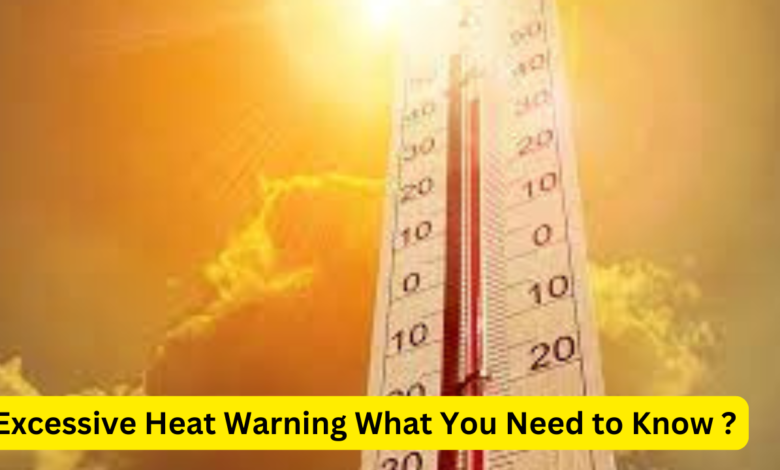
Excessive heat warning are crucial alerts issued to protect the public during extreme weather conditions. These warnings are particularly significant in areas prone to high temperatures, as they highlight the potential dangers associated with prolonged exposure to heat. In this comprehensive guide, we will delve into the various aspects of excessive heat warnings, including their definitions, impacts, and ways to stay safe.
What is an Excessive Heat Warning?
An excessive heat warning is issued by meteorological agencies when temperatures are expected to reach dangerously high levels. This warning indicates that the heat will be of such intensity that it poses a significant risk to health, particularly for vulnerable populations such as the elderly, children, and those with pre-existing medical conditions.
Criteria for Issuing Excessive Heat Warnings
Excessive heat warnings are based on several criteria:
- Temperature Thresholds: The primary criterion is the temperature itself. Typically, warnings are issued when the heat index, which combines temperature and humidity, exceeds a specific threshold. For example, a heat index of 105°F (40.5°C) or higher might trigger a warning.
- Duration of Heat: The length of time that temperatures are expected to remain at dangerous levels also plays a role. Warnings are often issued when high temperatures are anticipated to persist for an extended period, such as three or more consecutive days.
- Humidity Levels: High humidity can exacerbate the effects of heat, making it feel even hotter. When humidity levels are elevated, the risk of heat-related illnesses increases, prompting the issuance of warnings.
Impacts of Excessive Heat
Excessive heat can have severe impacts on both health and infrastructure. Understanding these impacts is crucial for preparing and protecting oneself during extreme heat events.
Health Risks
The primary health risks associated with excessive heat include:
- Heat Exhaustion: This condition results from prolonged exposure to high temperatures and can lead to symptoms such as heavy sweating, weakness, dizziness, and nausea. If not addressed promptly, it can escalate to more severe conditions.
- Heat Stroke: Heat stroke is a medical emergency that occurs when the body’s core temperature rises to dangerous levels. Symptoms include a high body temperature, rapid pulse, confusion, and loss of consciousness. Immediate medical attention is required to prevent serious complications or death.
- Dehydration: Excessive heat increases the body’s need for fluids. Failure to stay hydrated can lead to dehydration, which impairs physical and mental performance and can exacerbate heat-related illnesses.
- Exacerbation of Pre-existing Conditions: Individuals with chronic conditions such as cardiovascular or respiratory diseases may experience worsened symptoms during extreme heat, increasing the risk of adverse health outcomes.
Infrastructure and Environmental Impact
- Power Outages: High temperatures often lead to increased energy consumption, particularly for air conditioning. This surge can strain electrical grids, potentially leading to power outages.
- Wildfires: Excessive heat combined with dry conditions can increase the risk of wildfires, posing threats to communities and natural habitats.
- Transportation Disruptions: Extreme heat can cause road surfaces to buckle and damage transportation infrastructure, leading to potential delays and hazards for drivers.
Safety Tips During Excessive Heat
To stay safe during excessive heat warnings, it is essential to follow these guidelines:
Stay Hydrated
- Drink Plenty of Water: Aim to drink at least 8-10 glasses of water a day. Avoid beverages with caffeine or alcohol, as they can contribute to dehydration.
- Monitor Fluid Intake: Increase fluid intake if you are engaging in physical activities or spending extended time outdoors.
Limit Exposure to Heat
- Stay Indoors: If possible, remain indoors during the hottest parts of the day. Use air conditioning or fans to keep cool.
- Avoid Strenuous Activities: Reduce physical exertion, especially during peak heat hours. If outdoor activities are necessary, take frequent breaks and hydrate regularly.
Check on Vulnerable Individuals
- Monitor the Elderly and Sick: Check on elderly relatives, neighbors, and those with health conditions to ensure they are managing well during extreme heat.
- Offer Assistance: Provide help with accessing air-conditioned spaces or arranging transportation if needed.
Cool Your Environment
- Use Fans and Air Conditioning: Utilize fans to circulate air and air conditioning to maintain a cool indoor temperature.
- Close Blinds and Curtains: Block direct sunlight to reduce indoor temperatures.
- Cool Down with Water: Take cool showers or baths to lower body temperature.
Recognize Heat-Related Illnesses
- Know the Symptoms: Be aware of symptoms of heat exhaustion and heat stroke. Seek medical attention if these symptoms are observed.
- Apply First Aid: If someone shows signs of heat-related illness, move them to a cooler place, hydrate them, and apply cool, wet cloths to their body.
Community and Government Measures
Governments and communities play a vital role in managing and mitigating the effects of excessive heat. These measures include:
Public Awareness Campaigns
- Heat Health Advisories: Authorities issue advisories to inform the public about the risks of excessive heat and provide safety tips.
- Emergency Alerts: Utilize emergency alert systems to quickly disseminate information about heat warnings and safety measures.
Cooling Centers
- Establish Cooling Stations: Provide designated cooling centers in communities for individuals without access to air conditioning.
- Public Access: Ensure these centers are accessible to those in need, including transportation options for those without personal vehicles.
Infrastructure Improvements
- Urban Planning: Incorporate heat-resilient materials and designs in urban planning to reduce the heat island effect and improve cooling efficiency.
- Energy Grid Enhancements: Invest in infrastructure improvements to prevent power outages during peak heat periods.
Conclusion
Excessive heat warnings are critical for safeguarding health and well-being during extreme weather conditions. By understanding the criteria for these warnings, recognizing the potential impacts, and following recommended safety measures, individuals and communities can better prepare and protect themselves from the dangers of high temperatures.




